As a professional home cleaner serving Allen, TX and surrounding areas, I know just how much can hide beneath the surface of your carpet. From dust and allergens to bacteria and pet messes, carpets can impact the health of your home more than most people realize as supported by the study created by National Library of Medicine regarding on “Do Carpets Impair Indoor Air Quality and Cause Adverse Health Outcomes”.
Disinfecting your carpet doesn’t have to be complicated. With the right steps—and the right techniques for your specific carpet type—you can lift dirt, neutralize germs, and restore freshness. In this guide, I’ll walk you through the exact process we follow at Tidy Upped, from vacuuming and pre-treating stains to selecting safe disinfectants and ensuring proper drying.
Let’s get started on creating a cleaner, healthier home—one step at a time.
Table of Contents
- Why Carpet Disinfection Matters
- Quick Summary: Disinfection Methods by Carpet Type
- Supplies You’ll Need To Disinfect Carpet
- Step-by-Step: How to Disinfect Your Carpet at Home
- How to Disinfect Without a Steam Cleaner
- Common Mistakes to Avoid
- Special Scenarios: Extra Precautions You Should Take
- Carpet Disinfection Maintenance Tips
- FAQs About Carpet Disinfection
- When to Call the Pros
- Final Thoughts: A Cleaner Carpet = A Healthier Home
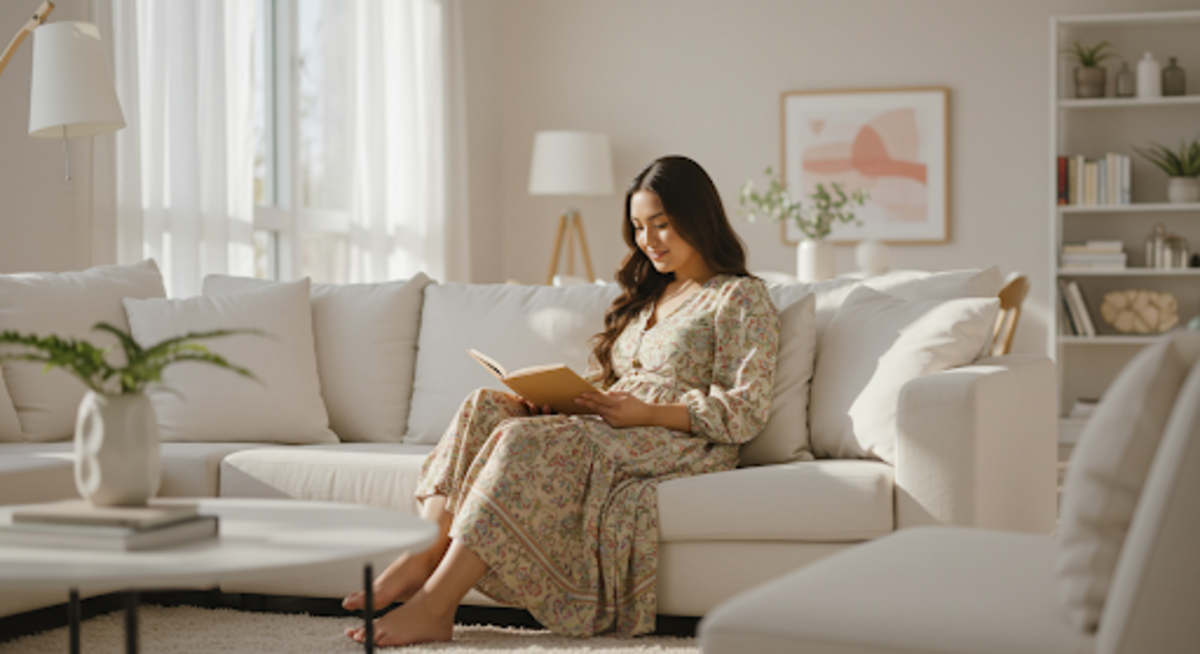
Why Carpet Disinfection Matters
Disinfecting your carpet isn’t just about appearances—it’s about protecting your health. As a professional cleaner, I’ve seen how much dust, allergens, and bacteria can build up in carpets over time, especially in high-traffic areas.
Carpets can trap everything from pet dander and pollen to germs and viruses. Left untreated, these particles may contribute to respiratory issues, allergies, and even recurring illness—especially in homes with children, elderly family members, or pets.
Regular disinfection helps reduce these risks while restoring a fresher, cleaner environment. I’ve worked with many clients—including vacation rental and Airbnb hosts—who noticed fewer allergy symptoms and improved indoor air quality after a deep carpet clean.
We believe that a clean home is a healthy home—and your carpet plays a big role in that.
Quick Summary: Disinfection Methods by Carpet Type
Not every carpet responds the same way to cleaning and disinfection. As someone who’s worked with all kinds of carpet textures and materials, I always tailor my approach to suit the specific fiber type. Here’s a quick summary of what I recommend for the most common carpets:
- Synthetic (Nylon, Polyester, Olefin): Use a mixture of mild detergent and water, scrub lightly, and extract with a wet vacuum. Durable and easy to disinfect.
- Wool: Stick with gentle, natural disinfectants like vinegar or baking soda. Avoid high heat or harsh chemicals, which can shrink or damage the fibers.
- Berber (Loop Pile): Steam cleaning is effective here, but go easy—agitation can snag the loops.
- Plush / Saxony: Use low-moisture methods and soft brushes to avoid flattening the pile. A quality extractor helps lift dirt from deep fibers without overwetting.
- Frieze (Twist Pile): Use a disinfectant spray and soft brush to reach between the twists. Avoid overwetting to prevent mildew.
- Cut and Loop: Disinfect gently to preserve the pattern. Use a carpet-safe disinfectant and blot or extract carefully.
Supplies You’ll Need To Disinfect Carpet
When it comes to disinfecting carpets the right way, having the proper supplies makes all the difference. I always make sure to gather everything I’ll need ahead of time so the process goes smoothly from start to finish.
Below, I’ll walk you through the tools and cleaning agents I personally rely on to get professional-grade results—without compromising your family’s health or safety.
Tools & Equipment
The right tools not only make carpet disinfection easier—they make it more effective. Here’s what I reach for every time I prepare to deep clean a carpet:
- Vacuum Cleaner – A high-powered vacuum lifts dirt and debris from deep within the carpet, setting the stage for effective disinfection.
- Carpet Brush – I use this to gently agitate and loosen stubborn grime, especially in high-traffic areas.
- Spray Bottle – Essential for applying your disinfectant evenly and precisely, especially if you’re treating specific zones.
Cleaning & Disinfecting Agents (Safe & Effective Options)
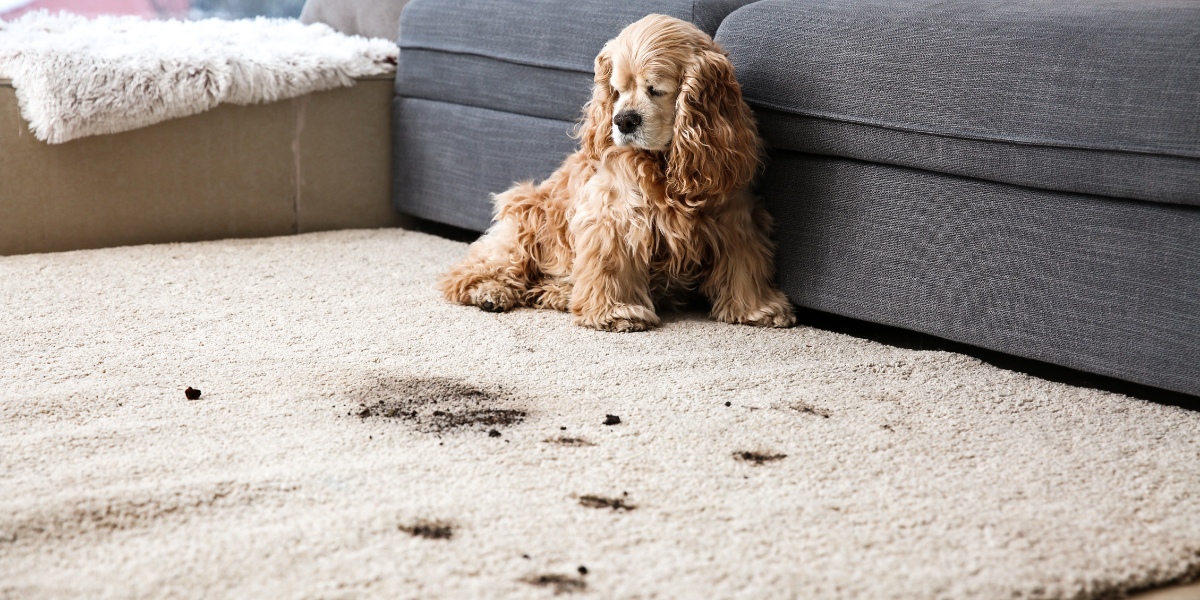
Choosing the right cleaning agents is just as important as how you apply them. I always prioritize products that are both tough on germs and safe for the people and pets in your home.
Some of my go-to options include:
- Eco-Friendly Store-Bought Cleaners – I look for labels like “biodegradable,” “non-toxic,” or “pet-safe.” These products strike a good balance between performance and peace of mind.
- Natural Solutions – Vinegar and baking soda are time-tested staples. I often combine vinegar with water for general disinfection, and baking soda works wonders for absorbing odors.
- Essential Oils (Optional) – A few drops of tea tree or lavender oil added to your cleaning mix can provide extra antibacterial properties—and make your home smell amazing.
Whether I’m using commercial products or natural alternatives, I always double-check that they’re carpet-safe and compatible with the specific type of fiber I’m working on.
Step-by-Step: How to Disinfect Your Carpet at Home
Now that I’ve gathered my supplies, it’s time to get to work. Disinfecting your carpet doesn’t have to be overwhelming—when done methodically, it can actually be pretty straightforward.
Here’s the exact process I follow at Tidy Upped to ensure a clean, sanitized result every time.
Step 1: Prep the Area (Move Furniture, Open Windows)
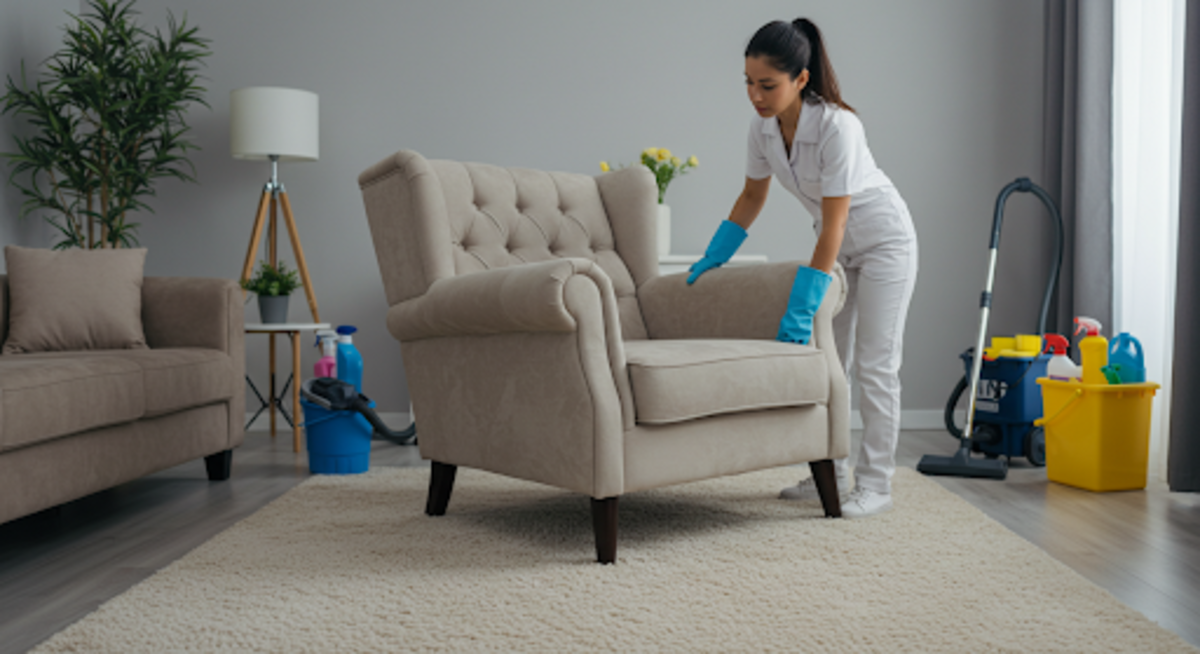
Before disinfecting, I always make sure the space is prepped and ready to go. A little preparation helps me clean more efficiently and ensures better results.
Here’s what I recommend:
- Move Furniture – Shift furniture off the carpet to expose as much surface area as possible. This helps reach dirt and bacteria hiding underneath.
- Open Windows – Good ventilation keeps air fresh and helps reduce drying time later.
- Clear Clutter – Remove small items, rugs, and toys so you can focus solely on the carpet.
With a clear, open area, you’ll be ready to clean thoroughly and safely.
Step 2: Vacuum Thoroughly
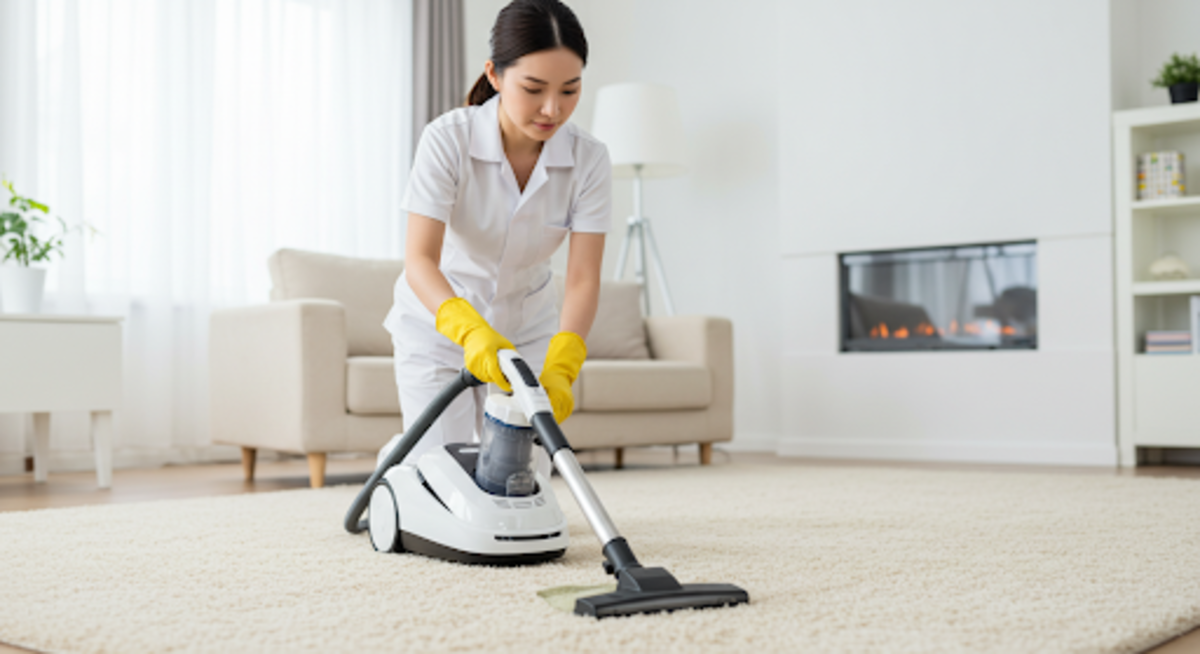
Vacuuming is more than just a surface clean—it’s a critical first step that removes dust, allergens, and debris embedded deep in the carpet fibers.
I always vacuum in slow, overlapping strokes, going over each section multiple times. This gives the machine time to lift up what’s buried beneath the surface.
Pro tip: use your vacuum’s hose or crevice tool along edges and baseboards. These areas tend to collect more dirt than most people realize.
Step 3: Pre-Treat Stains
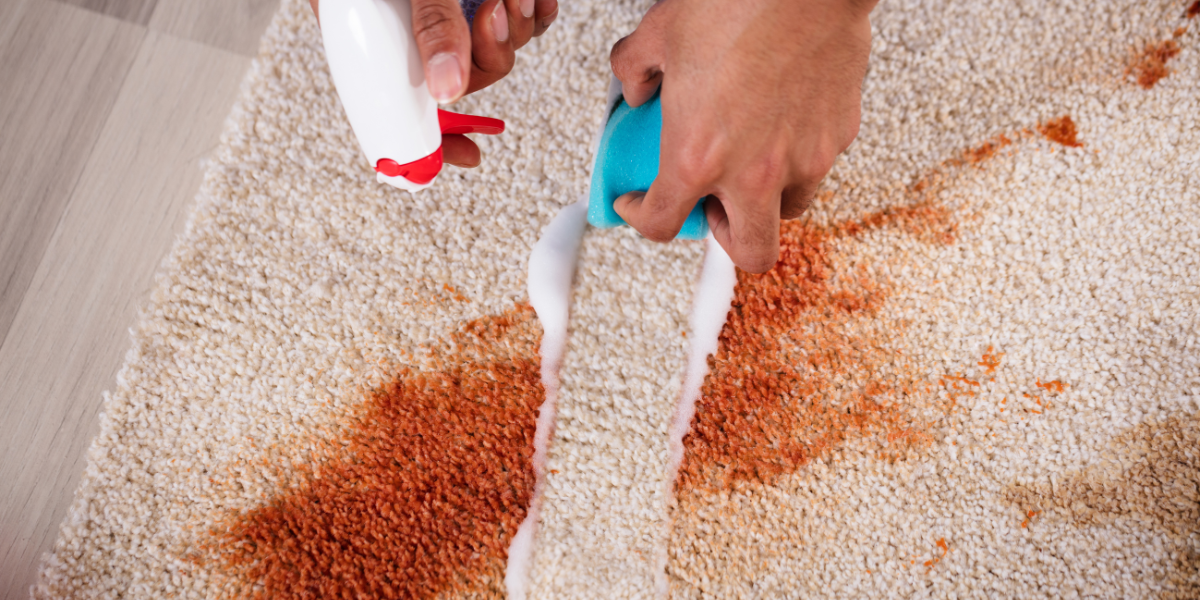
Before applying any disinfectant, I always take the time to address visible stains. Treating them first not only improves the appearance of the carpet—it also prevents the stains from setting deeper once moisture and heat are introduced during cleaning.
Here’s my step-by-step approach:
- Identify the stain – I start by determining what caused the stain—whether it’s pet urine, red wine, coffee, grease, or something else. Knowing the source helps me choose the right cleaning method and avoid damaging the carpet fibers.
- Blot, don’t rub – Rubbing can push the stain deeper or damage the carpet pile. Instead, I blot the area gently with a clean, absorbent cloth or paper towel to lift as much of the substance as possible without spreading it.
- Apply a targeted cleaner – Depending on the stain type and the carpet material, I use either a professional-grade spot remover or a natural solution like white vinegar and water. For protein-based stains (like blood or dairy), an enzymatic cleaner often works best. I always test on an inconspicuous area first to ensure the product doesn’t cause discoloration.
Prompt treatment is key here. The sooner a stain is addressed, the better the chance of full removal—especially in high-traffic homes or vacation rentals, where quick turnover and lasting impressions matter.
Step 4: Choose the Right Disinfection Method
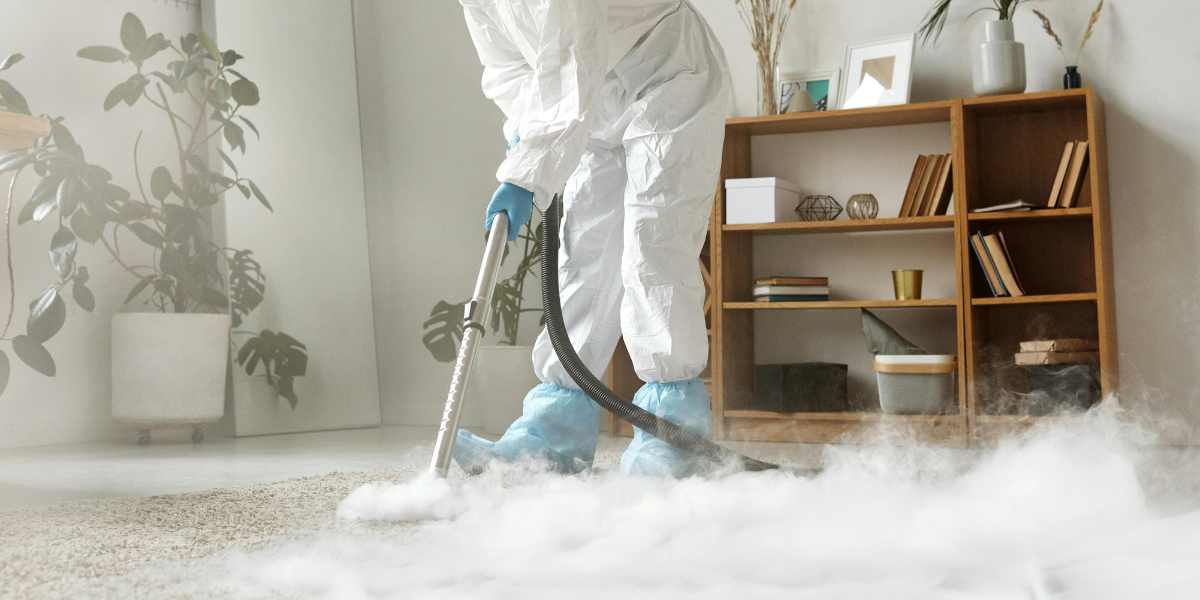
There’s no one-size-fits-all approach when it comes to disinfecting carpets. I always choose a method based on the carpet type, household needs, and whether pets or children are present.
Some effective options include:
- Steam Cleaning – A favorite for many carpet types, steam kills germs using high heat.
- Eco-Friendly Disinfectant Sprays – Great for spot-treating or low-moisture cleaning.
- DIY Natural Solutions – A vinegar-based spray or baking soda can be surprisingly effective for regular maintenance.
- Carpet Shampooing – Involves using a carpet shampoo machine and a disinfectant shampoo solution. It’s effective but can leave residue if not rinsed thoroughly.
- Enzyme Cleaners – Especially useful for organic messes like pet accidents. These break down bacteria at the molecular level and are usually non-toxic.
- Hydrogen Peroxide Solutions – A diluted 3% hydrogen peroxide spray can disinfect and brighten light-colored carpets. Caution: it may bleach darker fibers.
- Professional Antimicrobial Treatments – Some cleaning services (like Tidy Upped!) offer hospital-grade disinfectants that eliminate bacteria, viruses, and fungi more effectively than DIY solutions.
If you’re unsure which method is safest for your carpet, it’s always wise to consult a professional—or let me handle it for you!
Step 5: Apply & Agitate the Disinfectant
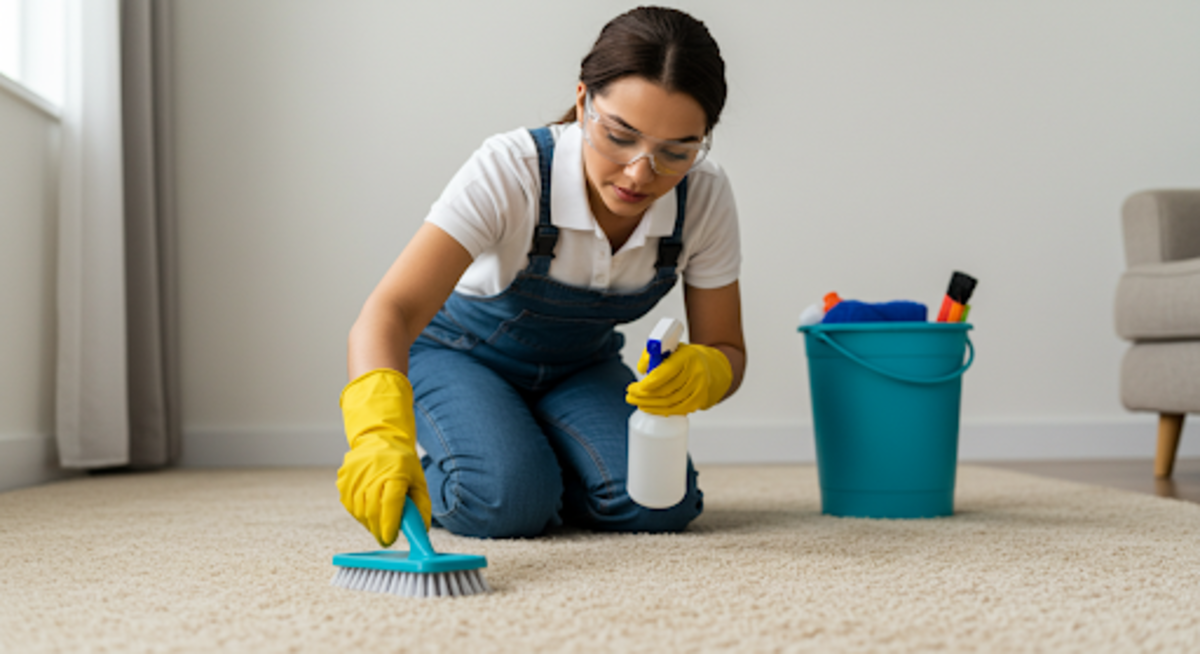
With the right disinfectant selected, it’s time to apply it—and make sure it actually gets to work.
I always recommend using a spray bottle or carpet sprayer for even coverage, especially on high-traffic zones where germs tend to gather. Here’s the method I use in client homes and can confidently recommend:
How I Do It:
- Apply Evenly: Spray the disinfectant in a light, even mist. You don’t need to soak the carpet—just make sure the surface is well-covered.
- Let It Sit: Give it a few minutes to activate. Check the label for exact timing—some need just 5 minutes, others closer to 10.
- Agitate Gently: Using a soft-bristle carpet brush or microfiber cloth, gently work the product into the fibers. This helps the solution reach below the surface for a deeper clean.
- Focus on High-Touch Areas: Pay extra attention to walkways, under couches, and kids’ play areas. These spots need more love.
When disinfecting professionally, I’ve seen how this simple step helps boost effectiveness without damaging carpet fibers. The key is to be thorough, but gentle.
Step 6: Rinse or Extract (if needed)
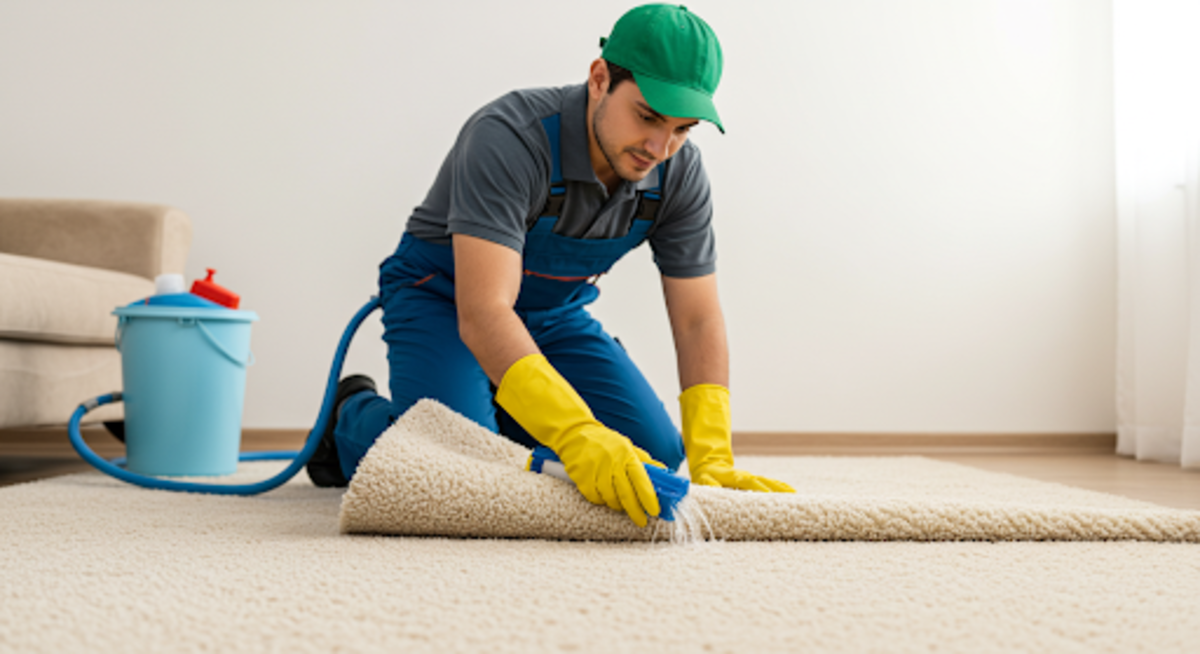
Once the disinfectant has done its job, it’s time to remove any leftover product—especially if you’re using a solution that isn’t designed to dry clean.
In many of the homes I clean, this step makes all the difference between a fresh carpet and one that feels sticky or leaves behind residue.
Here’s how I rinse or extract:
| Method | How It Works | Best For |
| Hot Water Rinse | Use a carpet cleaner with hot water to flush out residue | Thick carpets or heavy soiling |
| Wet Vacuum Extraction | A wet/dry vacuum pulls out moisture and leftover product | Quick drying and medium-pile carpet |
| Steam Cleaning | Penetrates fibers with heat and moisture, removing germs and residue | Stains, odors, or post-illness care |
| Manual Blotting | Use clean towels to blot out excess moisture by hand | Small or delicate carpeted areas |
After applying the rinse method, I always do a touch test. If the carpet feels sticky or damp after a few hours, I know it needs more extraction or better airflow.
The goal here is simple: no residue, no excess moisture—just a clean, safe surface under your feet.
Step 7: Let It Fully Dry (Ventilation tips)
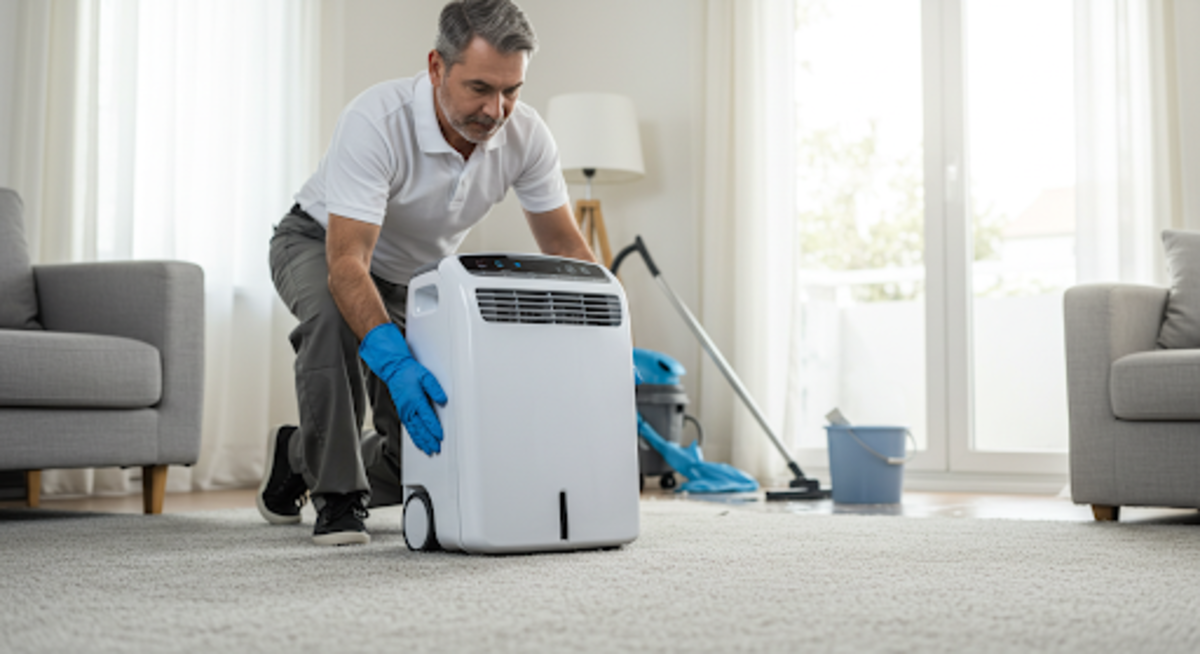
After rinsing or extracting, drying your carpet properly is just as important as the cleaning itself. If moisture lingers too long, it can lead to mold, mildew, or that dreaded musty smell.
Whenever I disinfect carpets in my clients’ homes, I always take time to ensure the drying process is done right.
Here’s how I speed things up:
- Open the Windows: Fresh air is your best friend. I open up as many windows as possible to get cross-ventilation going.
- Turn on Fans: Box fans, ceiling fans, or even HVAC systems help push air through the fibers and speed up evaporation.
- Use a Dehumidifier: In humid Texas weather, I’ll often run a dehumidifier to pull moisture from the air and carpet more quickly.
- Avoid Heavy Traffic: While drying, I recommend keeping foot traffic off the carpet—especially from pets or little ones!
Most carpets dry within 6 to 12 hours, but it depends on the thickness and ventilation. I always check with a clean, dry hand before putting furniture back in place.
Taking the time to dry properly not only protects your carpet but also supports a truly clean, healthy home.
How to Disinfect Without a Steam Cleaner
Steam cleaning is powerful, but it’s not your only option. Whether you’re in between professional cleanings or just don’t have a steam cleaner on hand, there are effective alternatives I use for clients when steam isn’t practical or necessary.
Here are some natural, accessible methods I trust to freshen and disinfect carpets safely:
| Method | How I Use It |
| Vinegar + Water | I mix equal parts white vinegar and water in a spray bottle, then lightly mist the carpet. It helps neutralize bacteria and odors. Let it sit for 5–10 minutes before blotting. |
| Baking Soda | Sprinkle generously over the carpet, let it sit for 15–30 minutes to absorb odors, then vacuum thoroughly. I use this between deeper cleanings to maintain freshness. |
| Essential Oils | A few drops of tea tree or lavender oil in your vinegar mix adds natural antibacterial power and a pleasant scent. Just be sure to avoid oils that may irritate pets. |
These gentle, chemical-free options are ideal for families with kids, pets, or sensitive allergies. When I use these methods for clients, they often tell me the house just feels fresher—without that harsh cleaner smell.
If you’re not ready for a deep steam, these are great go-to options to keep your carpet healthy and clean in the meantime.
Common Mistakes to Avoid
After years of cleaning carpets in homes across Allen, TX and nearby areas, I’ve seen a few common missteps that can make disinfecting less effective—or even damaging. Avoiding these simple mistakes can save your carpet and improve your results.
Here are a few things I always watch out for:
- Using the Wrong Disinfectant
Not all disinfectants are safe for carpet. I make sure to check that any product I use is fabric-safe and won’t damage fibers or leave harmful residues behind. - Skipping the Vacuuming Step
I can’t stress this enough—always vacuum first. Otherwise, you’re just spreading dirt around. Removing surface debris helps the disinfectant actually reach the bacteria and grime below. - Overapplying Product
It’s easy to think more product means a better clean, but too much disinfectant can soak into the padding, cause mildew, and leave residue that attracts more dirt over time. I stick to the recommended amount and apply it evenly. - Poor Drying Practices
If the carpet stays damp too long, you’re inviting mold and bacteria right back in. I always ensure proper ventilation and use fans or a dehumidifier when needed.
By avoiding these pitfalls, you can get better results, protect your carpet, and maintain a healthier home long-term.
Special Scenarios: Extra Precautions You Should Take
There are times when disinfecting your carpet goes beyond routine cleaning. Whether you’re dealing with illness, pet accidents, or water damage, I take special care to go a step further to protect the health of everyone in the home.
After Illness (Flu, COVID-19, Stomach Bug)
When someone in the household has been sick, I recommend a more thorough disinfection to help prevent germs from lingering. Here’s what I typically do:
- Vacuum thoroughly to remove any surface particles.
- Apply a disinfectant that’s safe for fabrics, and let it sit for the full recommended contact time.
- Use steam cleaning, if available, to add heat-based sanitizing power.
This extra care gives my clients peace of mind that their home is truly refreshed and safe again.
Pet Accidents and Odor
I love pets, but I know accidents happen. When they do, fast action is key:
- Blot up the mess quickly to avoid it soaking into the padding.
- Apply a pet-safe disinfectant that targets both bacteria and odor.
- Neutralize odors naturally with baking soda, then vacuum once dry.
By acting fast and using pet-safe products, I help clients maintain a clean home without compromising their pets’ health.
Water Damage or Mold Risk
Water damage is one of the biggest threats to carpet hygiene. If I suspect water has seeped in, I take these steps immediately:
- Extract moisture with towels or a wet vac.
- Use fans or a dehumidifier to dry the area thoroughly within 24–48 hours.
- Disinfect the carpet and apply a mold inhibitor to reduce the risk of long-term issues.
Time really matters in these situations. The sooner it’s addressed, the better the outcome.
Carpet Disinfection Maintenance Tips
A one-time deep clean is important—but keeping your carpet truly healthy requires consistent maintenance. I always remind my clients that small, regular habits not only preserve the look and feel of your carpet, but also help prevent bacteria, allergens, and odors from building up over time.
Here are my go-to tips for keeping carpets cleaner, longer:
- Vacuum at least once a week – In high-traffic areas, homes with pets, or vacation rentals, aim for 2–3 times a week. Regular vacuuming removes surface dust, dirt, and allergens before they settle deep into the fibers.
- Treat spills right away – Blot, don’t rub. I recommend using a mild detergent or a natural mix of white vinegar and water to neutralize stains and prevent bacterial growth.
- Disinfect monthly – Use a carpet-safe disinfectant or a steam cleaner once every 4 weeks to sanitize high-traffic areas. This helps break down bacteria, dust mites, and lingering odors before they can take hold.
- Deep clean every 3–6 months – A professional deep carpet cleaning is ideal for lifting embedded dirt and restoring freshness. I usually recommend this quarterly for most homes, or more often for families with pets, young kids, or allergy concerns.
- Schedule maintenance cleaning every 6–8 weeks – Our maintenance carpet cleaning service is perfect for keeping things fresh between deep cleans, especially in homes with frequent guests or busy routines.
- Sprinkle baking soda between cleanings – It’s a quick and easy way to absorb odors. Just let it sit for a few hours (or overnight) before vacuuming.
- Use doormats at entrances – These trap dirt before it enters your home. I also suggest making your home a shoe-free zone to reduce germs and outdoor residue in your carpet.
With just a little attention each week—and a smart cleaning schedule—you can significantly extend the life of your carpet and maintain a healthier, fresher home year-round.
FAQs About Carpet Disinfection
I get a lot of questions from clients about carpet disinfection—what works, what doesn’t, and how to do it safely. Let me walk you through some of the most common concerns and what I recommend based on experience.
Can I use vinegar to disinfect carpet?
Yes, vinegar can help disinfect your carpet—but with a few caveats. I like to use a mix of equal parts white vinegar and water in a spray bottle. It’s great for neutralizing odors and addressing mild bacteria.
Just keep in mind:
- Always spot test in a hidden area first—vinegar is acidic and can affect color on some carpets.
- It’s not a hospital-grade disinfectant, so for high-risk areas or after illness, I recommend pairing it with a deeper clean or a professional service.
Is steam cleaning enough to kill germs?
Steam cleaning is one of the most effective methods I use to sanitize carpets. The heat penetrates deep into the fibers and can kill many bacteria, dust mites, and allergens—without needing harsh chemicals.
That said, for carpets exposed to bodily fluids or pet accidents, I sometimes combine steam with a disinfectant spray for extra peace of mind.
How long should disinfectant sit?
Disinfectants need time to work. I usually let mine sit for at least 5 to 10 minutes—but always follow the product label for exact timing. A few tips I go by:
- Keep the room at room temperature for best results.
- Make sure the carpet is evenly sprayed so no spots are missed.
- Don’t rush this step—letting it dwell is key to killing germs effectively.
Will bleach ruin carpet?
In most cases, yes—bleach will damage your carpet. It can discolor the fibers, break down the backing, and leave behind a chemical smell that’s tough to get rid of.
Instead, I recommend safer options like:
- Hydrogen peroxide (3%) for spot disinfection.
- Vinegar and water, or
- A carpet-safe, non-toxic disinfectant spray.
It’s always best to avoid bleach unless you’re treating an all-white, synthetic rug that can handle it—and even then, do a test spot first.
When to Call the Pros
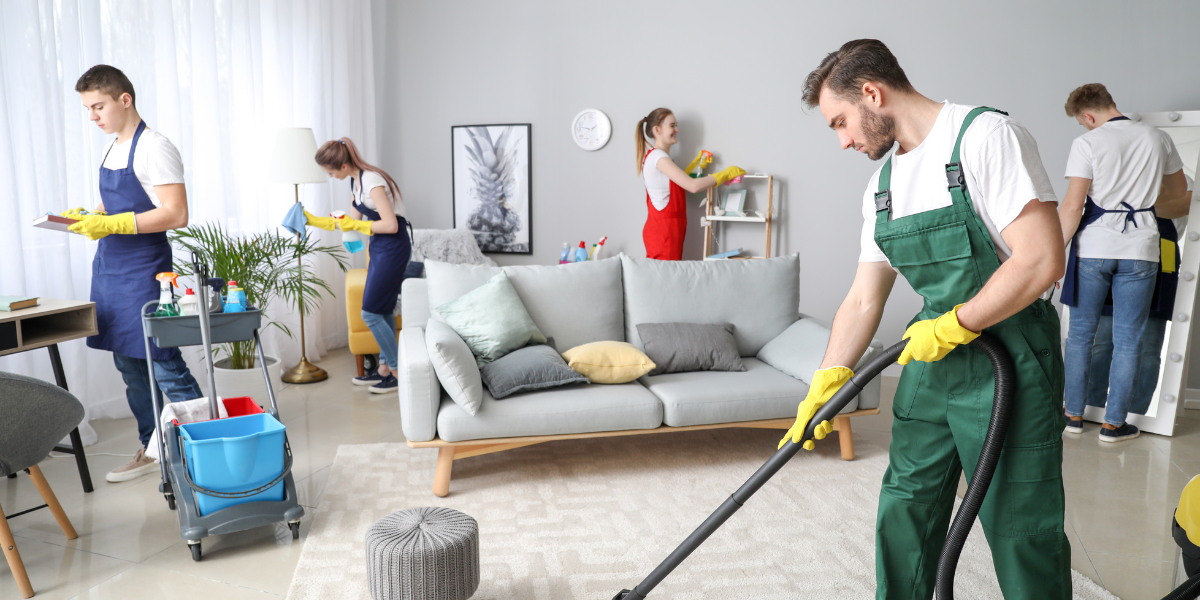
Even with the best intentions and solid DIY methods, there are times when it’s best to let a professional step in—especially when your carpet needs more than just a surface-level clean.
As a professional cleaner, here’s when I recommend giving us a call:
1. After Illness or Contamination
If someone in your home has been sick or there’s been an accident involving bodily fluids, it’s crucial to disinfect properly. I use commercial-grade solutions and equipment that reach deep into carpet fibers—far beyond what household products can do.
2. Persistent Odors
Pet urine, mildew, or lingering smoke smells? These are tough to eliminate with basic sprays. I’ve found that high-powered extraction combined with odor-neutralizing treatments works best. If the smell keeps coming back, it’s time for a deep professional clean.
3. Allergies Acting Up
Dust mites, pollen, and mold spores can build up in carpets and trigger allergies. If vacuuming and basic cleaning aren’t helping, a hot water extraction or steam cleaning can remove irritants more thoroughly.
4. Stains That Keep Reappearing
Ever clean a stain only to see it come back days later? That’s usually because it seeped into the carpet pad. I use specialized tools and techniques to flush out deep-set stains and prevent them from resurfacing.
5. Annual or Bi-Annual Deep Cleans
Even if your carpet looks clean, I always recommend scheduling a professional clean at least once or twice a year. It not only keeps your home healthier, but it also extends the life of your carpet—especially in high-traffic areas.
If you’re in Allen, TX or a nearby area, let Tidy Upped take it from here. I’d be happy to bring that fresh, professionally cleaned feeling back to your home—with safe, effective methods that protect your family and your carpet.
Final Thoughts: A Cleaner Carpet = A Healthier Home
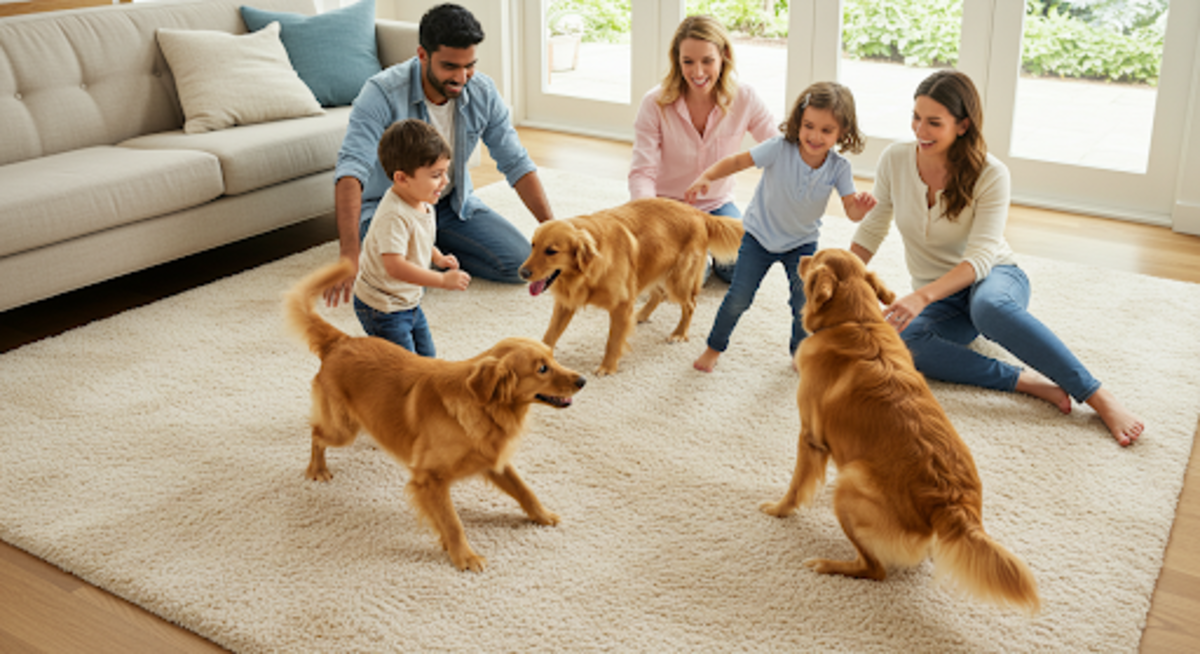
At the end of the day, disinfecting your carpet isn’t just about keeping things looking nice—it’s about creating a home that supports your family’s health and comfort.
I’ve seen firsthand how regular cleaning and disinfection can reduce allergens, eliminate odors, and create a noticeably fresher space. Whether you’re dealing with pets, kids, or just everyday traffic, taking care of your carpets makes a real difference.
And while there’s a lot you can do on your own, don’t hesitate to reach out when things get a little too deep—or when you just want peace of mind. At Tidy Upped, we’re here to help you maintain a cleaner, healthier home, one carpet at a time.
So go ahead—schedule that cleaning, grab that brush, or call in the pros. Your home (and your lungs) will thank you.

Leave A Comment